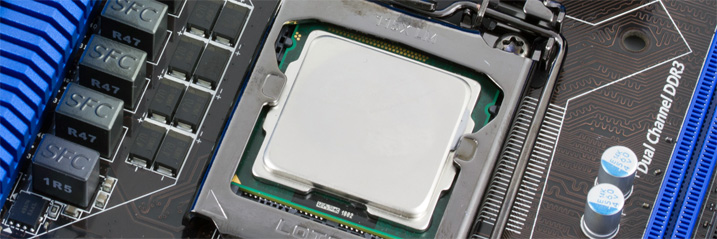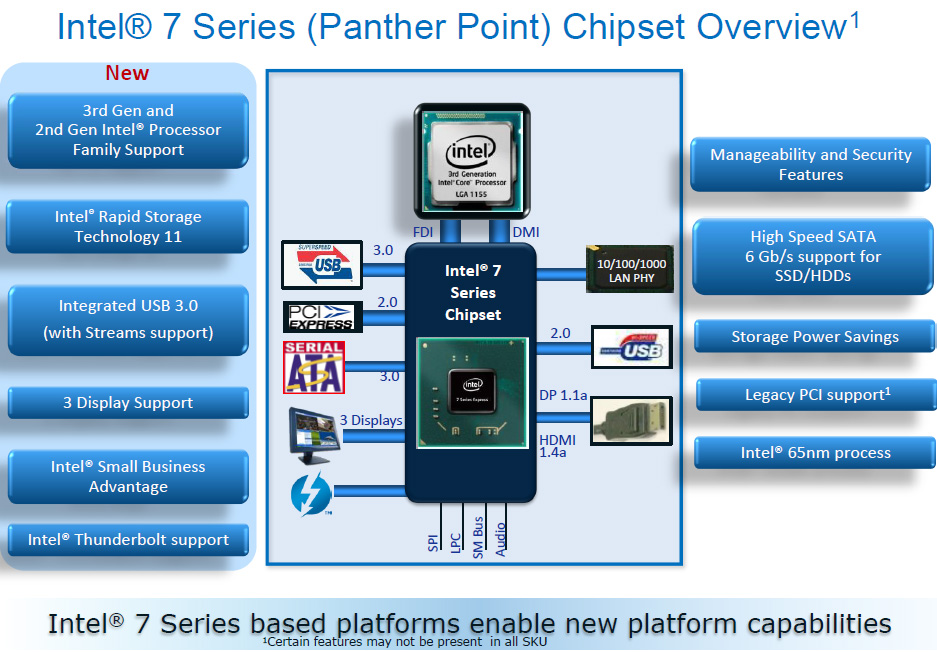Intel ha entered phase one of the launch of the new processor platform Ivy Bridge. Unfortunately it is without any processors from said processor family but instead the new 7 series chipsets that are ready. Intel launches Z77, Z75 and H77, which also supports Sandy Bridge.
That Intel starts the launch with the 7 series chipset may seem a bit boring, but at the same time expected. We have seen motherboards sporting the new chispets for a couple of months now and already back at CES in Las Vegas in January we saw early samples of the now launched motherboards.
While waiting for the new Ivy Bridge architecture Inl and its motherboard partners have released a whole armada of new motherboards and the heart of them all is the new 7 series chipsets, code-named Panter Point. The flagship is called Intel Z77 and is both the one we recommends and the one we will see in the majority of boards in the future.
LGA1155 also supports Sandy Bridge
Launching new motherboards without the processor they are intended for is of course a bit backwards, but the explenation is simply because it is quite similar to last generation 6 series chipsets. The most important of all is that they use the same LGA1155 socket, which means it supports Sandy Bridge processors. The new generation motherboard will work just as well with Sandy Bridge as with Ivy Bridge, but there are a number of functions that are not support by current Intel processors.
This is the reason we at NordicHardware have decided to hold off our motherboard reviews until we have Ivy Bridge processors to test with and write about, the new 7 series chipsets deserves to stretch its legs and they will get a chance real soon.
The power of three – PCI Express 3.0, USB 3.0 and three displays
Intel builds the new chipset series on the same base as the older 6 series, but there are bigger news, or more precise three bits of news. Intel’s new chipset supports the new USB 3.0 format for many times faster transfer to compatible USB units. As usual you need SSD-based USB units for the truly impressive speeds, but now there is four USB 3.0 ports baked into the actual chipset.
PCI Express 3.0 gives us twice as much bandwdith per channel, which is also new for the chipset. For users that will run configurations with multiple graphics cards the physical PCIe x16 slots can be forced down to x8 or even x4 bandwidth, but through PCI Express 3.0 there will still be lots of bandwidth.
Last but not least the Panter Point chipset supports up to three monitors at the same time. This is a function tied directly to the new graphics processor found inside the Ivy Bridge architecture and will only work with the latest generation Core processors.
Below is a quick walkthrough of the three new chipset that launches today, compared to the last generation 6 series.
| Chipset | Z77 | Z75 | H77 | Z68 | P67 | H67 | X79 (LGA2011) |
| Intel Smart Response Technology | Yes | No | Yes | No | Yes | ||
| Overclocking support |
Yes | No | Yes | No | Yes | ||
| Integrated graphics support |
Yes | No | Yes | – | |||
| Monitor support |
3 | 2 | – | 2 | – | ||
| USB 2.0 (USB 3.0) |
14 (4) | 14 | |||||
| SATA 3.0 (6.0) Gb/s | 6 (2) | ||||||
| PCI Express 2.0 |
8 | ||||||
| Thunderbolt | 1 | – | |||||
| Official PCI Express 3.0 support | Yes | No | |||||
| DDR3 | 2800 MHz | 2133 MHz | |||||
As the table reveals Intel has some more improvements to show with the new chipset series. First of all there is much better memory support with the new platform. Motherboards with the new 7 series chipset supports DDR3 speeds up to 2800 MHz and the more efficient DDR3L standard.
There is also support prepaed for the new high-speed interface Thunderbolt. With data speeds up to 10 Gbps Thunderbolt is best known for its integration in Apple’s MacBook family, but now Intel’s technology (irony?) will also come to the PC platform. The controller circuit is not baked into the Panter Point chipset, but all 7 series chipsets are prepared for connecting four PCI Express channels to an external Thunderbolt circuit if the motherboard manufacturers finds it suitable.
Those who can’t wait another few weeks to see how the motherboards perform with the right partner, the new Ivy Bridge processors, there is already a whole lot of models available in stores. Below are some listed with the chipset and formfactor.
| Motherboard | Chipset | Formfactor |
| ASUS Maximus V Gene | Intel Z77 | Micro-ATX |
| ASUS P8Z77-V Pro | Intel Z77 | ATX |
| ASUS P8Z77-I Deluxe | Intel Z77 | Mini-ITX |
| Gigabyte GA-Z77X-UD5H | Intel Z77 | ATX |
| Gigabyte G1.Sniper 3 | Intel Z77 | ATX |
| Gigabyte GA-H77M-D3H | Intel H77 | Micro-ATX |
| MSI Z77A-GD65 | Intel Z77 | ATX |
| MSI Z77A-GD80 | Intel Z77 | ATX |
| MSI H77MA-G43 | Intel H77 | Micro-ATX |
| ASRock Fatal1ty Z77 Professional | Intel Z77 | ATX |
| ASRock Z77 Extreme4-M | Intel Z77 | Micro-ATX |
| ASRock Z75 Pro3 | Intel Z75 | ATX |
| Intel DH77EB | Intel H77 | Micro-ATX |
We will follow up on Intel’s new processor architecture together with the new 7 series, but also investigate each board individually.






















Leave a Reply